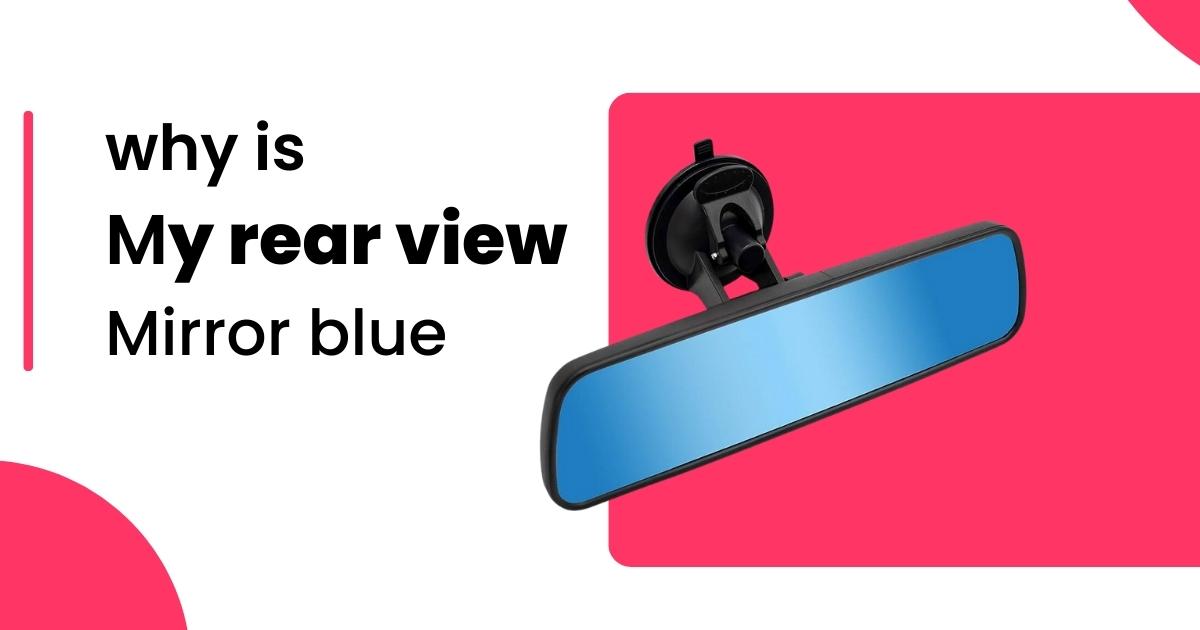Why is My Rear View Mirror Blue? Here is The Truth!
The rear view mirror is a seemingly ordinary component of your vehicle, but its impact extends far beyond mere reflection. As such, any abnormality with this mirror can be a cause for alarm, and, more importantly, it can pose a safety hazard.
A typical scenario is the rear view mirror turning blue unexpectedly. In some applications, the tint change may seem ordinary at first, but it can be more than a mere aesthetic concern. So, if you notice something like this happening, it’s important to pay attention because it could be more than just a change in appearance.
Why is My Rear View Mirror Blue?
If you’ve been wondering why your rear view mirror appears to have a mysterious blue tint, you’re not alone. There’s been quite a buzz across various car forums, where vehicle owners voice their concern about this intriguing occurrence.

One motorist shared their experience, noting “Hey everyone, had a bizarre situation today. I parked my car to run some errands, and when I returned, fired up my car, my rear view mirror turned blue! At first, I thought maybe someone pulled a prank and tinted my mirrors while I was in the store, but nope, the actual mirror crystal itself took on a smoky blue hue. I’m aware of the auto-dimming setting, but this seems stuck. Day or night, they’re stuck in this blue mode for a whole day now. Has anyone else experienced this?”
Now, if your car comes with an electrochromic rear view mirror, this should be a less of concern. These mirrors are equipped with advanced technology that allows them to automatically adjust their tint based on ambient light conditions. The mirrors use a special coating that changes its opacity in response to headlights or bright sunlight, thereby facilitating dynamic tinting, usually a fairly blue tint.
As such, the blue tint you observe in your rear view mirror may be a normal part of the dimming process. A blue tint mirror serves the specific purpose of preventing glare from auto high beams, especially during nighttime driving.
You can conduct an easy experiment by flashing a light on to rear view mirror light sensor and observing how it responds. The light sensor is typically located on the back of the mirror, facing towards the windshield.
As you shine the flashlight on the light sensor, observe the mirror’s reaction. You should notice it adjusting its tint or angle to reduce glare, just as it would when faced with actual bright headlights. As a result, you may see the mirrors shift to a blue tint. The blue hue often indicates that the mirror is actively adjusting to reduce brightness and enhance visibility.
Blue rear view mirror benefits include;
Auto-Dimming
With auto-dimming technology, there’s no need for manual adjustments when transitioning from daylight to evening driving. The mirror automatically senses ambient light conditions and adjusts its tint accordingly. This convenience ensures that drivers can focus on the road without the distraction of glare from headlights behind them.
Consistent Dimming
Auto-dimming technology provides a consistent and optimal level of dimming at all times. Whether it’s a gradual transition from day to night or sudden changes in lighting conditions, the mirror adapts seamlessly to maintain the ideal level of brightness, thereby promoting safer driving.
Clearer View
Compared to traditional rear view mirrors, auto-dimming mirrors often offer a clearer and sharper view. They achieve this by adjusting the tint to minimize glare, which enhances visibility and reduces eye strain.
Other Causes of Blue Rear View Mirror
Auto dimming is designed to improve visibility and reduce the glare of the rear view mirror in response to ambient light. However, it’s important to note that there are other factors that are not related to auto-dimming that can contribute to the appearance of a blue tint in rear view mirrors. These include;
Sensor obstruction
As we have mentioned, the auto-dimming feature relies on the light sensor to assess ambient light conditions and make necessary adjustments to the tint level of the mirrors. If the sensor is obstructed or covered, it may misinterpret the lighting conditions, leading to incorrect tint adjustments, including unnecessary dimming.
In situations where the sensor is blocked, the mirrors might dim even when it’s not required, such as during the daytime or when there’s not enough ambient light to warrant dimming. These adjustments may lead to undesired outcomes such as a persistent blue tint or an inability to effectively reduce glare during nighttime driving.
Always ensure you clean the sensor area to avoid such problems in the future. In addition, remove obstacles like hanging items and avoid placing tinted objects in front of the mirror. You may also want to check for snow or ice in cold weather to help reduce the risk of incorrect tint adjustments.
Electrical Issues
Electrical issues within the auto-dimming system can also lead to unexpected tint changes. Ideally, the complex interplay of the light sensor and the electrochromic layer makes this mirror susceptible to disruptions such as short circuits or faulty components.
When this happens, it can lead to communication errors, which can manifest as unintended changes in the mirror’s tint. You can start by checking the vehicle’s electrical system for any potential malfunctions or faults. If you suspect short circuits or faulty components, consider taking your vehicle for thorough inspection and repair.
Physical Defects
In rare cases, manufacturing defects in the rear view mirror can also lead to abnormal tint changes. These defects can disrupt the sensor’s ability to modulate tint effectively, causing deviations from the intended functionality of the auto-dimming system.
Also Read: Why is My Negative Battery Cable Smoking? Facts You Should Know
This could include an unintended blue tint or irregular responses to light conditions. In cases of manufacturing defects, the only solution is liaising with the manufacturer for the replacement of the defective component.
Signal Interference
Signal interference from nearby electronic devices can also interfere with the mirror’s light sensor. As a result, the sensor might misinterpret the ambient lighting conditions and trigger an unexpected tint change. In such cases, consider using shielding devices or electromagnetic interference filters if available. Repositioning electronic devices away from the sensor area can also help minimize disruptions.
The Bottom Line
Tinted mirrors are not necessarily a cause for alarm. As we have mentioned, modern rear view mirrors come with auto-dimming technology, which can include a blue tint to reduce glare from headlights during nighttime driving. This is often a deliberate design, which help enhance visibility by minimizing distracting and blinding light from other vehicles.
However, if the blue tint is unexpected, persistent, or occurring during the day when it’s not intended to, it could indicate a malfunction or an issue with the auto-dimming system. In such cases, it would be advisable to consult the vehicle’s manual or seek professional assistance to diagnose and address any problems with your rear view mirror.






